Fantastic Four: First Steps | Who is Galactus?
Who is Galactus? The Devourer of Worlds
The Cosmic Entity Coming to Fantastic Four: First Steps
By Azeem_USA
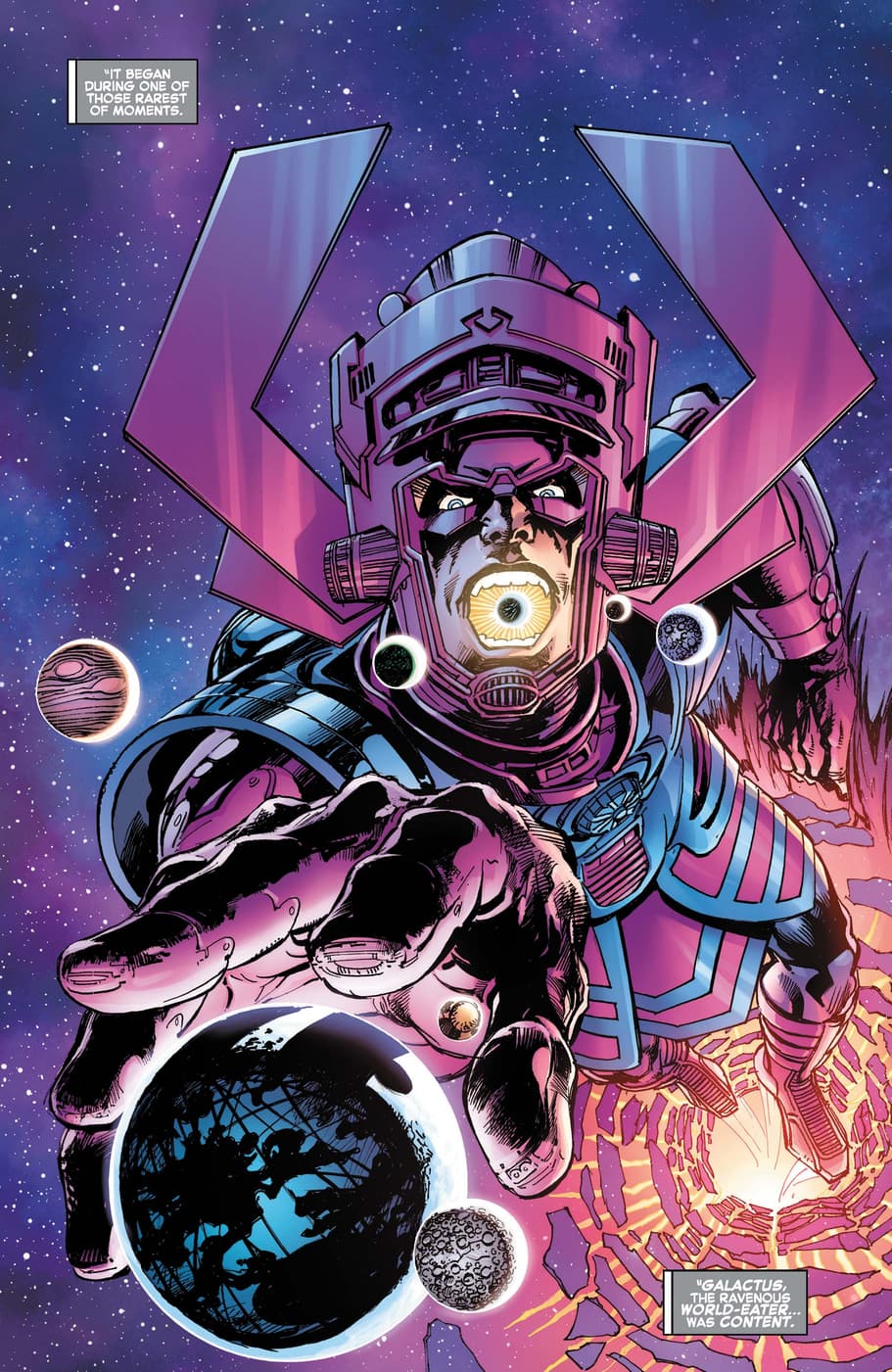
Table of Contents
Introduction to Galactus
In the vast cosmos of Marvel Comics, few entities inspire as much awe and dread as Galactus, the Devourer of Worlds. Neither hero nor villain in the conventional sense, Galactus exists as a force of nature—a cosmic entity whose hunger for planets is necessary for the balance of the universe. As the Fantastic Four: First Steps movie prepares to introduce this iconic character to the Marvel Cinematic Universe in 2025, it's the perfect time to explore who Galactus is, where he came from, and why his existence matters.
"Galactus is neither good nor evil. He simply is." - Silver Surfer
Standing taller than mountains when at full size, adorned in his signature purple and blue armor with a distinctive horned helmet, Galactus represents one of Jack Kirby and Stan Lee's most innovative creations. First appearing in Fantastic Four #48 (1966), he transcended the typical comic book antagonist archetype to become something more profound—a cosmic constant whose actions, while devastating to inhabited worlds, serve a higher purpose in the universe's natural order.
As we delve into the story of Galactus, we'll explore his origins in a previous universe, his transformation into the planet-consuming entity we know today, his complex relationship with his heralds (particularly Silver Surfer), and what his appearance might mean for the future of the Marvel Cinematic Universe.
Origin: Galan of Taa
The being now known as Galactus began his existence as Galan, a scientist from the planet Taa in the reality that existed before our current universe. Taa was part of the sixth cosmos in Marvel's multiverse mythology—a cosmos where science was the primary focus and all planets were technologically advanced.
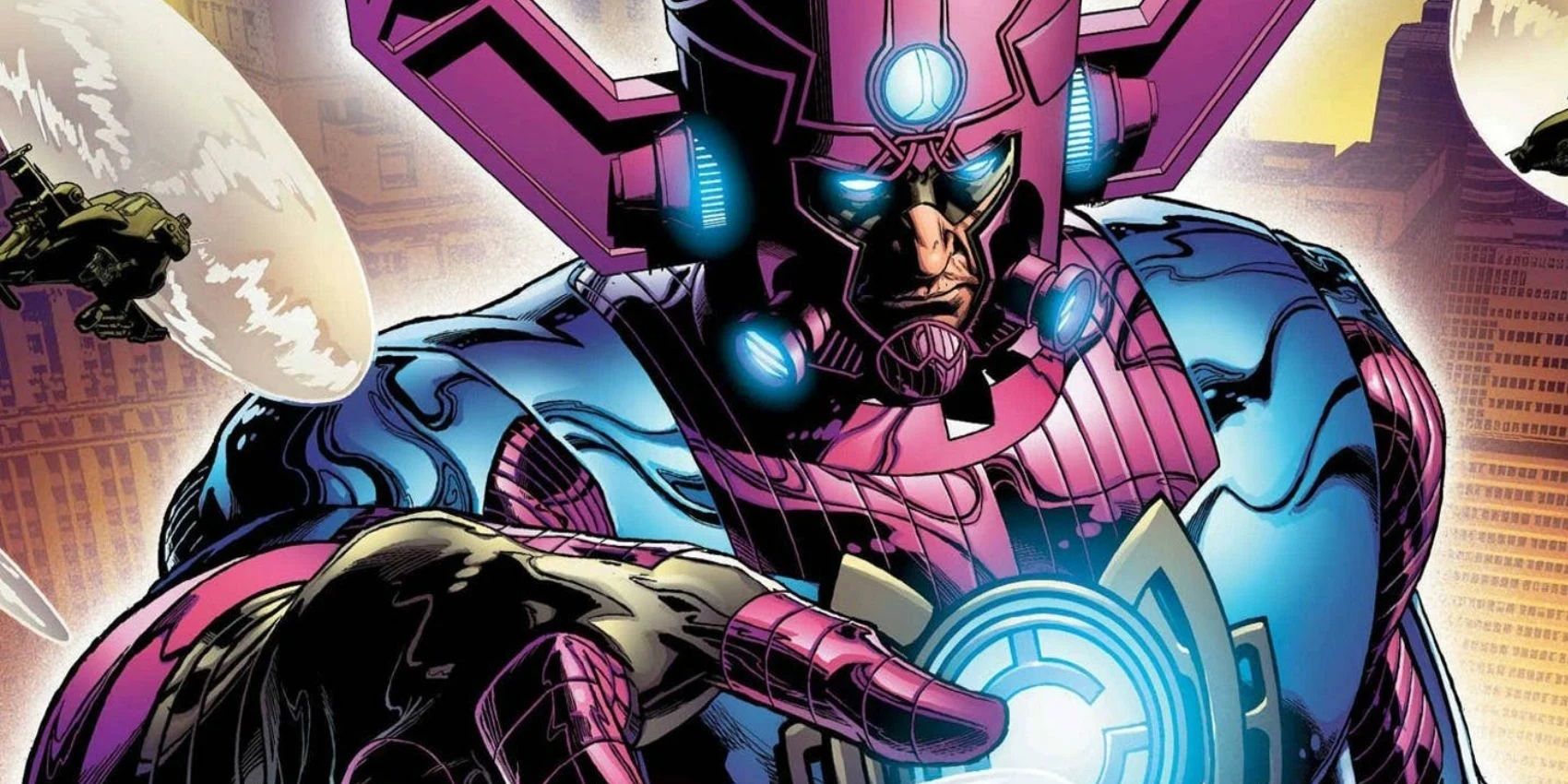
Galactus origin story from Marvel Comics

Super-Villain Classics: Galactus the Origin #1 (1983)
Galan was a genius scientist who had combined his DNA with a donor to create a child. Taa, like the rest of this universe, was eventually threatened by a cosmic plague known as the Black Winter—an entity even more powerful than Galactus that consumed entire universes rather than just planets.
As his universe began collapsing around him, Galan built a ship to explore what he called the "Cosmic Egg"—the center of the universe. When his planet was on the verge of destruction, Galan and other astronauts ventured forth in this ship, but only Galan survived the journey to the universe's core.
While the details of what happened next have been retconned over the years, the most consistent narrative is that Galan encountered the Sentience of the Cosmos as the sixth universe collapsed. This cosmic entity merged with Galan, transforming him and preserving him through the death of the old universe and the birth of the new one (the "Big Bang" that created our current universe).
Galan's ship, now transformed into an incubation chamber called the "Lifebringer One," drifted through space as its occupant underwent a profound metamorphosis. For eons, the being who was once Galan incubated inside, evolving into something new—a cosmic entity that would become known as Galactus.
The Cosmic Life Cycle
To understand Galactus, it's essential to grasp Marvel's concept of cosmic life cycles. In Marvel cosmology, the multiverse undergoes cycles of death and rebirth. Each complete cycle is called a "cosmos," and the current Marvel universe exists in the seventh cosmos.
Each cosmos develops with a specific focus—the third or fourth cosmos focused on magic, the sixth on science, and so on. Though each cosmos eventually ends, certain elements from each one carry forward to the next cycle. For example, if magic was created in the fourth cosmos, it would continue to exist in the fifth cosmos and beyond.
In this cosmic understanding, Galactus serves a crucial function. When the sentient beings known as the Eternals appeared in the seventh cosmos (our current universe), including entities like Eternity, Infinity, Death, and Entropy, Galactus emerged as a balancing force in the cycle of life and death. His role became to maintain balance by consuming planets—effectively pruning the universe to prevent overpopulation and sustain the cosmic order.
This is why Galactus is often described as being neither good nor evil—he is a fundamental cosmic force, as necessary to the universe as gravity or time. Without his consumption of planetary energy, the universe's natural balance would collapse.
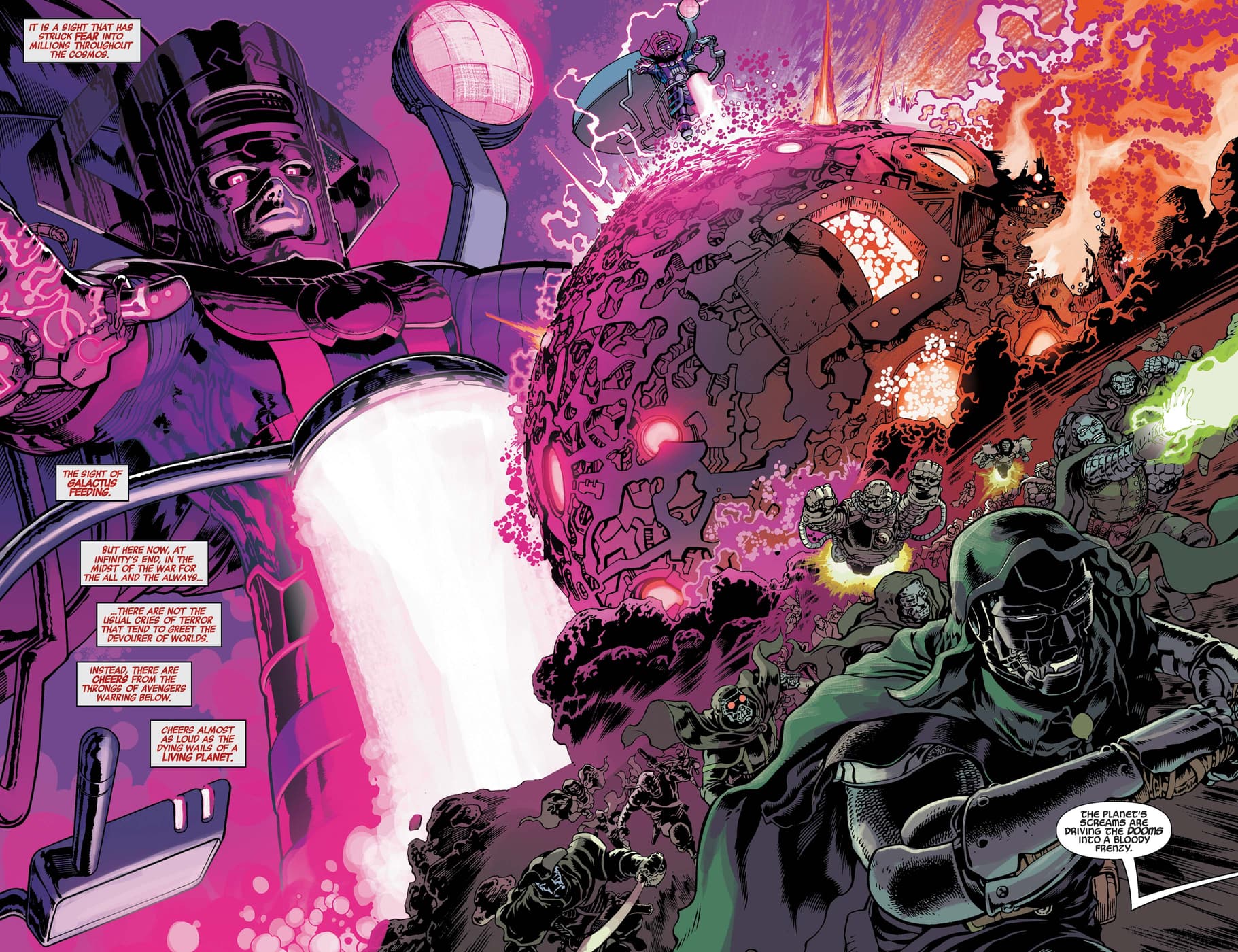
Galactus stands as a cosmic force of balance in the Marvel Universe
Black Winter and Galactus
The relationship between Galactus and the Black Winter represents one of the more fascinating aspects of his backstory. While Galactus is immensely powerful, consuming planets to satisfy his hunger, the Black Winter is even more terrifying—it consumes entire universes.
In recent comic storylines, it was revealed that the Black Winter actually saved Galan during the death of the sixth cosmos, but with an ulterior motive: Galactus was meant to serve as the Black Winter's herald. Just as Galactus has heralds like Silver Surfer who find planets for him to consume, Galactus himself was intended to be the herald of the Black Winter, locating universes for it to devour.
This revelation recontextualizes Galactus's role in the cosmic hierarchy. While he is a force of necessary destruction within our universe, he is also a servant to an even greater cosmic power. The Black Winter represents a threat that even Galactus fears, giving the Devourer of Worlds a vulnerability that makes him more complex as a character.
The Black Winter storyline also connects to Thor in recent Marvel comics, where the God of Thunder faces this cosmic threat with Galactus as an uneasy ally. This demonstrates how Galactus can shift between antagonist and reluctant partner depending on the scale of the threat faced by the Marvel universe.
Silver Surfer: The Herald of Galactus
After consuming planets for millennia, Galactus realized he needed to be more efficient in his feeding. To satisfy his ever-growing hunger, he created heralds—beings empowered with the "Power Cosmic" who would search the universe for suitable planets for him to consume.
The most famous of these heralds is Norrin Radd, better known as the Silver Surfer. When Galactus threatened to consume Zenn-La, Norrin's home planet, the scientist offered himself in service to Galactus in exchange for sparing his world and his beloved Shalla-Bal.
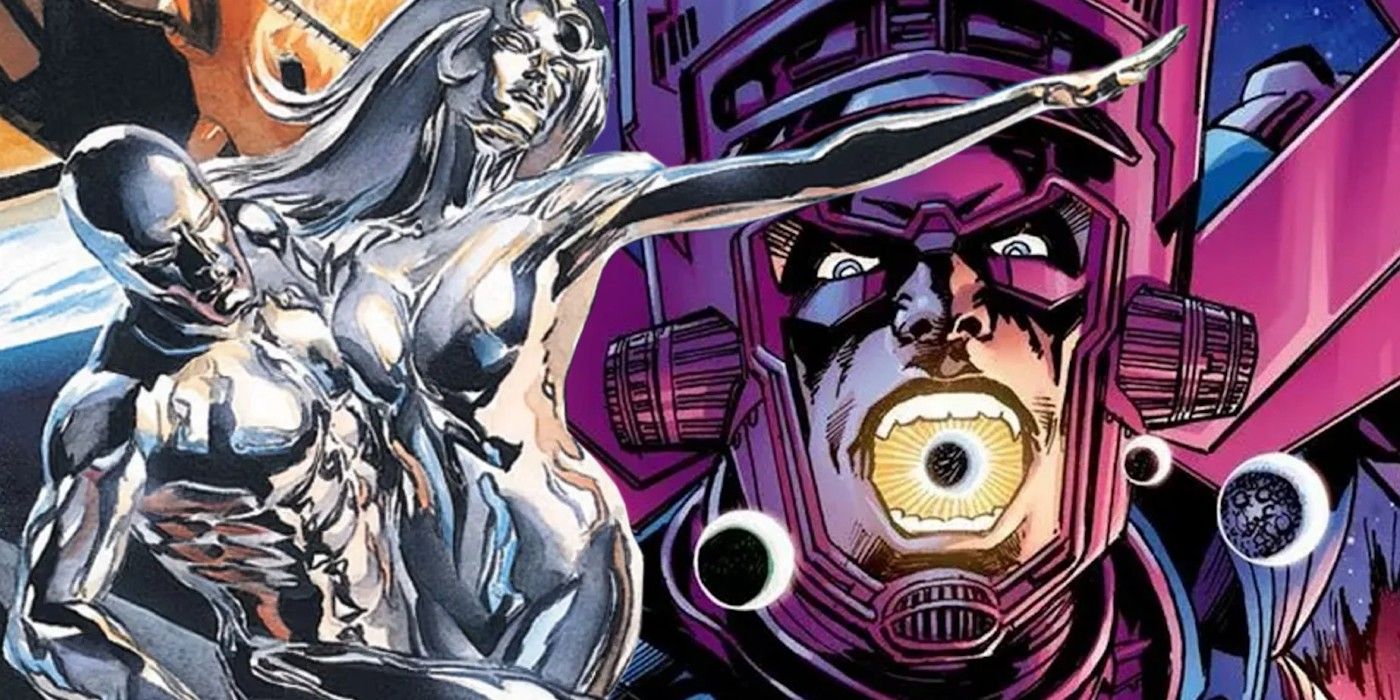
Norrin Radd, Shalla-Bal, and Galactus in Marvel Comics
Galactus accepted this offer, wiped Norrin's memories, and transformed him into the Silver Surfer—a cosmic being who travels through space on a silvery board, searching for planets to satisfy his master's hunger. For centuries, the Silver Surfer dutifully served Galactus until he came to Earth.
On Earth, something about humanity reconnected the Silver Surfer to his conscience. With help from the Fantastic Four, he rebelled against Galactus, choosing to defend Earth rather than deliver it to his master. This betrayal led to a complex relationship between the two cosmic beings, with the Surfer often working to prevent Galactus from consuming inhabited worlds.
The relationship between Galactus and Silver Surfer highlights the moral complexity of Galactus as a character. While Galactus is not malevolent, his cosmic hunger leads to the destruction of civilizations, creating an inherent tension that drives many Marvel cosmic storylines.
Shalla-Bal: The Female Silver Surfer
While Norrin Radd is the most recognized Silver Surfer in the main Marvel universe, the upcoming Fantastic Four: First Steps film introduces audiences to Shalla-Bal as a female Silver Surfer. This character does exist in Marvel Comics lore, though in a different context than what the film may present.
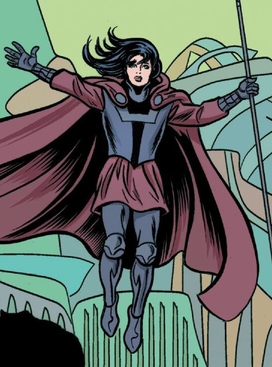
Shalla-Bal as depicted in Marvel Comics
In the main Marvel continuity (Earth-616), Shalla-Bal is Norrin Radd's beloved and the Empress of Zenn-La. She is left behind when Norrin becomes the Silver Surfer to save their planet. Their separation becomes a source of emotional turmoil for the Silver Surfer throughout his cosmic journeys.
However, in an alternate universe of Marvel's multiverse, there exists a different story. In this reality, after Galactus is defeated, the cosmic balance is disturbed. To restore order, Franklin Richards (son of Reed and Sue Richards of the Fantastic Four) becomes that universe's Galactus. In this continuity, there are two Silver Surfers—Norrin Radd and Shalla-Bal—who serve as dual heralds.
The presence of Shalla-Bal as Silver Surfer in the upcoming film suggests that The Fantastic Four: First Steps may be drawing from this alternate universe storyline, or creating its own interpretation of the character. This innovative approach allows the MCU to introduce a female Silver Surfer while potentially setting up interesting narrative possibilities for future films.
In comics, Shalla-Bal eventually dies in a conflict with Celestials, but her appearance in the MCU could take her character in entirely new directions, possibly giving her a more prominent role than she had in the source material.
Powers and Abilities
Galactus ranks among the most powerful beings in the Marvel universe, possessing abilities that border on omnipotence. His powers stem from the "Power Cosmic," a fundamental force of the universe that Galactus commands with unparalleled mastery.
Core Powers of Galactus:
- Size Manipulation: Galactus can alter his size according to his will. He can appear human-sized when interacting with beings on planets, or expand to the size of a planet when consuming worlds.
- Reality Manipulation: Galactus can reshape matter and energy at will, creating or destroying as he sees fit.
- Energy Projection: He can channel the Power Cosmic into devastating blasts capable of destroying planets.
- Telepathy: Galactus possesses vast telepathic abilities that allow him to communicate across cosmic distances.
- Cosmic Awareness: He can sense disturbances in the fabric of space-time and perceive events across the universe.
- Immortality: Galactus does not age and cannot die by conventional means, though his power levels fluctuate based on his energy reserves.
- Molecular Restructuring: He can transform beings, as he did when creating his heralds like Silver Surfer.
- Perception Alteration: Each species perceives Galactus differently—he appears to each according to their cultural understanding of cosmic power.
- Teleportation: Galactus can transport himself and others across vast cosmic distances instantaneously.
Importantly, Galactus's power level is directly tied to his hunger. When well-fed (having consumed planets recently), he ranks among the most formidable beings in existence, capable of challenging cosmic entities like Eternity or the Celestials. When starving, his powers diminish, making him vulnerable to defeat by sufficiently powerful opponents.
Another fascinating aspect of Galactus's design is his armor, which isn't merely decorative. The elaborate blue and purple suit serves a practical purpose—it helps regulate the immense cosmic energy contained within him. Without this regulator, the raw power of the cosmos might burst forth uncontrollably.

Galactus wielding the Power Cosmic, artwork by Alan Davis
Galactus in Fantastic Four: First Steps
The upcoming Marvel Studios film The Fantastic Four: First Steps, scheduled for release on July 25, 2025, will introduce Galactus to the Marvel Cinematic Universe. Based on the official synopsis and trailer, Galactus will serve as the primary antagonist, threatening Earth and forcing the newly formed Fantastic Four to defend their planet.

Concept image of Galactus from Fantastic Four: First Steps promotional materials
The film appears to be taking inspiration from classic Fantastic Four storylines while adding its own unique elements. Most notably, the MCU version features Shalla-Bal as the Silver Surfer rather than Norrin Radd, suggesting the film may draw from alternate universe storylines or create its own interpretation of the cosmic characters.
The trailer's retro-futuristic 1960s aesthetic pays homage to the original Lee-Kirby era of Fantastic Four comics, which first introduced Galactus. This stylistic choice may allow the film to capture the cosmic grandeur of those early stories while updating the narrative for modern audiences.
From what we've seen, the MCU's Galactus appears to maintain his classic design, complete with the iconic helmet and purple-blue armor. However, his size in the trailer has sparked discussion among fans, as he appears smaller than his comic counterpart who typically towers over planets. This could be explained by Galactus's ability to alter his size at will, or it might represent a different interpretation for the film.
As part of Phase Six of the MCU, Galactus's introduction likely has implications beyond this single film. In the comics, Galactus has connections to numerous cosmic entities and events, suggesting his appearance could herald a more cosmic focus for the MCU's future. With Avengers: Doomsday and Avengers: Secret Wars on the horizon, Galactus might play a role in these multiverse-spanning events.
Cosmic Significance in the Marvel Universe
Beyond his role as a world-devouring threat, Galactus serves several important functions in the Marvel Universe. Understanding these aspects helps explain why he has endured as one of Marvel's most fascinating cosmic characters for decades.
Balance of Cosmic Forces
Galactus exists as part of the cosmic balance. He represents a necessary force of destruction that prevents the universe from becoming overpopulated with life. This positioning makes him more complex than a typical villain—his actions, while devastating to individual worlds, serve a greater cosmic purpose.
The Ultimate Nullifier
One of the most powerful weapons in the Marvel Universe is the Ultimate Nullifier, a device capable of destroying entire realities. Galactus keeps this device safe, recognizing its dangerous potential. When the Fantastic Four first confronted Galactus, Reed Richards used the threat of the Ultimate Nullifier to convince Galactus to spare Earth—establishing a precedent that even cosmic entities can be reasoned with under the right circumstances.
Evolutionary Force
Galactus's presence in the universe serves as an evolutionary pressure. Civilizations must advance technologically and unite to survive his threat, pushing the development of species throughout the cosmos. Some storylines have even suggested that Galactus's consumption of planets may prevent greater cosmic disasters, making his destructive actions a necessary evil.
Philosophical Questions
Galactus raises profound philosophical questions about morality on a cosmic scale. Is an entity that destroys worlds to sustain itself evil if such consumption is necessary for universal balance? These questions have no easy answers, making Galactus one of Marvel's most morally complex characters.

Galactus represents a fundamental cosmic force in the Marvel Universe
In the broader Marvel storytelling tradition, Galactus often serves as a barometer for cosmic threats. When a new menace appears that can challenge or even frighten Galactus, readers understand immediately that this new threat exists on an almost unimaginable scale of power.
As the MCU continues to expand into the cosmic realm, Galactus's introduction in The Fantastic Four: First Steps may signal a new era focused on these larger cosmic threats and the philosophical questions they raise about existence, purpose, and the nature of good and evil on a universal scale.
Conclusion
Galactus stands as one of Marvel's most enduring and complex cosmic entities—neither hero nor villain, but a fundamental force of the universe. From his origins as Galan of Taa to his transformation into the Devourer of Worlds, his story spans universes and raises profound questions about cosmic balance and necessity.
As we anticipate his debut in the Marvel Cinematic Universe with The Fantastic Four: First Steps, fans can look forward to seeing how this iconic character will be interpreted for a new generation. Will the MCU Galactus be portrayed as the terrifying cosmic threat from the comics, or will the filmmakers find new dimensions to explore in this ancient, planet-consuming entity?
Whatever approach the film takes, Galactus's arrival signals the MCU's continued expansion into cosmic storytelling, opening the door to the vast, strange, and awe-inspiring corners of Marvel's universe that fans of the comics have cherished for decades.
The hunger of Galactus may be insatiable, but so too is the appetite of Marvel fans for these grand cosmic tales. As the Devourer of Worlds makes his way to the big screen, a new chapter in Marvel's cosmic saga begins.


Comments
Post a Comment